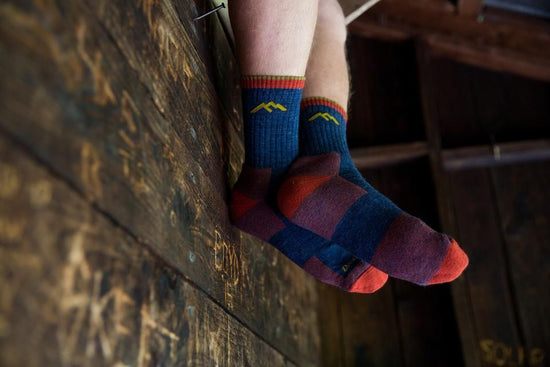When the snow is more than six-inches deep and has covered the ground for a while, you can be sure that, while you may see little wildlife activity above the snow, there is a good deal of it going on down below. This is because snow does not fall evenly across the land but is stopped by things such as tall grasses that bend beneath its weight, piles of leaves, and the gaps surrounding fallen branches and trees. These irregularities in the landscape create natural spaces beneath the snow that are added to by the tunnels, dens, and food caches excavated by the animals that remain active below the smooth, white cover on the surface.
The reason some animals and plants can live below the snow is because snow is a good insulator; one that holds in the heat that flows up from the ground below. This heat melts the lowest level of snow and the resulting water vapor rises and refreezes into a thin, icy ceiling. This process leaves a small space between the soil and the snow.
The space left by the melting and refreezing snow remains a constant 32° F. and, while it is not what we would call a comfortable temperature, it is warm enough to allow some animals to remain active during those months when the ground above is covered with snow. Scientists call this a subnivean (sub: under – snow; niveus) environment.
Spiders, mites, beetles, and some other insects are the smallest subnivean animals that can be seen by the naked eye. But the one most likely to be seen during a walk in the winter woods is the springtail. This common insect normally lives among the fallen leaves and other decomposing organic matter that lie on the ground. Yet, despite their abundance, we rarely ever see them except on warm days during the winter when they appear on the snow in such numbers that they look like blotches of soot.
Springtails get their name from their ability to catapult themselves through the air by means of a forked, tail-like structure that is attached on the underside of their abdomens, and it is their skill of jumping into the air that is the source of their other common name: snow fleas.
Look for springtails on sunny days near trees that have areas of melted snow around their bases. Springtails use these gaps in the snow as passageways to the surface. When the temperature drops, these insects will make a mass migration back down under the snow using the same melted spots that they used to come up.
Insects, seeds, plants and the bark from bushes and shrubs provide food for the deer mice and voles that are active beneath the snow. Both mice and voles will make extensive tunnels between their dens and sources of food, and when the weather warms, winding grooves in the snow will reveal where their burrows once were.
The snow provides small subnivean animals with protection from the frigid temperatures above and hides them from the sight of those predators that hunt on the surface. But they are not completely safe there, for shrews and weasels hunt for them by moving towards the scent of their prey while following the tunnels they dug in the snow.
Meanwhile, up on the surface; coyotes, fox, and bobcats, hunt by using their keen sense of hearing to locate animals travelling beneath the snow. They move cautiously, step by step, listening for the sound of movement and then, quickly, dive face first into the snow in an attempt to capture their prey.
The largest animal to remain active in the subnivean environment is the red squirrel. These active little creatures make tunnels between their dens and the places where they cached the green cones of pines and other conifers earlier in the year. These caches, called middens, can contain thousands of cones and be several feet wide and a foot or more high. The uneaten cones and the pile of leftovers from the squirrels feasting are hard to miss when the snow melts away in spring,
The most unexpected visitor to the under-snow world is the ruffed grouse. These birds dive headfirst down into the snow and then, using their wings and feet, dig short tunnels to keep themselves warm and safe from predators. This habit of “snow-roosting” can lead to a startling surprise when one of these birds jumps out from beneath a smooth stretch of snow right in front of you.
Go Below the Blanket ofSnow
If you would like to experience what it is like to live in a tunnel beneath the snow, try building a quinzhee (KWIN-zee). This is a native American snow shelter that will give you a new perspective about life in the subnivean world.
Building one of these “snow caves” is really quite easy. After a heavy snowfall, find and open space and build a big pile of snow. A pile 6-feet high and 10-feet wide will be enough for one adult and a child or two, but your pile will need to be another 5-feet wide if you want to fit three adults inside. Ultimately, the size of your pile really depends on your level of ambition and the number of helpers you can find.
Once you have built your pile, you need to let the snow set for several hours so the weight of the pile will cause the snow to recrystallize and harden. On a really cold day, three hours should be enough time, but it is even better if you can leave your pile overnight.
Next, get a short-handled spade or entrenching tool and tunnel into your pile at ground level. Your tunnel should be just wide enough for you to crawl into and about three feet long. Once this is done, begin scooping out the snow that is overhead and to the sides leaving the bottom (supporting) section until last. As the snow you are scooping away accumulates, push (or shovel) it out through the entrance.
When you see a section of the ceiling or wall is getting noticeably lighter than the rest, stop excavating snow from that area and start work elsewhere. By removing the snow only until outside light begins to filter in, you will allow the walls to be as thin as they can be while still being structurally sound.
Lastly, poke a small hole in the roof for ventilation, partially block the entrance with an extra jacket or blanket, and light a candle or turn on a flashlight. It will be quiet, windless, and warmer than you might imagine. Then let your thoughts turn to the other creatures that are moving around or sleeping beneath many of the snow-covered parts of the earth. For the moment, they are your fellow subniveans.



